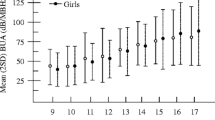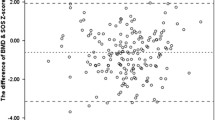Abstract.
There is a dearth of data on the prevalence of osteoporosis in Vietnam. This study was designed to preliminarily estimate the incidence of osteoporosis in the Vietnamese population. The study was designed as a population-based, epidemiological investigation. Men and women aged 18 years or above, who were residents of the City of Hanoi (Vietnam) and surrounding districts, and free of illnesses deemed to affect bone metabolism, were included in the study. Broadband ultrasound attenuation (BUA) was taken for each subject. The measurement was performed by a QUS-2 ultrasonometer at the calcaneus. The T-score of BUA was calculated as the number of standard deviations (SDs) from the value at peak BUA of young subjects. The age at peak BUA was estimated by a segmented linear regression model. A person was classified as having “low bone mass” if his/her T-score was less than −2.5. There were no interventions. Six hundred and sixty-eight men, aged 54.8 ± 17.2 years (mean ± SD), and 1390 women, aged 50.1 ± 12.9 years, participated in the study. BUA in men (81.3 ± 20.5 dB/MHz) was significantly higher than that in women (78.4 ± 18.7; P < 0.001). In each sex, age, body height, and body mass index were significant determinants of BUA, with the three factors collectively accounting for 25% of total variance of BUA. Peak BUA in men was 95 ± 20 and in women, 90 ± 16 dB/MHz. Age of peak BUA in men and women was 27 and 32 years, respectively. According to the instrument-derived T-score, 23.9% of men and 56.1% of women aged 60+ years were classified as osteoporotic. However, by using the data, 3.2% of men and 20% of women aged 60+ years were osteoporotic. The kappa statistic (a measure of agreement between the instrument T-score and data-derived T-score) was 0.65. It was concluded that the prevalence of low bone mass in the Vietnamese population, as estimated by BUA, was comparable to that in other Asian and Caucasian populations. The instrument-derived T-score is not appropriate for the diagnosis of osteoporosis in the Vietnamese population.
Similar content being viewed by others
Author information
Authors and Affiliations
Additional information
Received: May 20, 2002 / Accepted: August 12, 2002
Acknowledgments. The authors would like to thank the kind support of Hoffman-La Roche Ltd. Vietnam for providing the ultrasound machine which has been used in this study.
Offprint requests to: T.V. Nguyen
About this article
Cite this article
Thuy, V., Chau, T., Cong, N. et al. Assessment of low bone mass in Vietnamese: comparison of QUS calcaneal ultrasonometer and data-derived T-scores. J Bone Miner Metab 21, 114–119 (2003). https://doi.org/10.1007/s007740300019
Issue Date:
DOI: https://doi.org/10.1007/s007740300019




